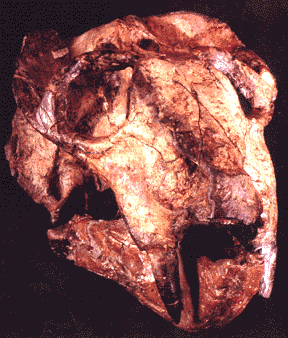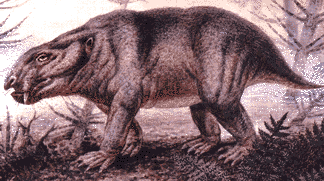
Dicynodon
trautscholdi -Amalitzky, 1922- skull
Therapsida: Anomodontia:
Dicynodontidae
Locality: Sokolki, Malaya Severnaya
Dvina River,
Arkhangelsk Region, northern European Russia
Age: Late Permian,
250 million years ago
Meaning of name: "Double dog tooth"
Size: medium-sized
domestic dog
There
were numerous anomodont therapsids of the genus Dicynodon in land
environments.
These bulky and clumsy animals made their way through thickset coastal
vegetation,
feeding on soft and juicy underground parts of large horstails.
Dicynodon possessed
nothing but a pair of exaggerated fangs in the upper jaw and the
lost teeth were
replaced by horn plates. The fangs became heavily worn when digging.
The above
skull is of this herbivorous dicynodont.
With the exception of its prominent
tusks, this animal was toothless.
Much like a turtle, it cropped vegetation with
a horny beak.
Dicynodonts were one of the more successful of the later therapsids,
persisting
until the very end of the Triassic.






